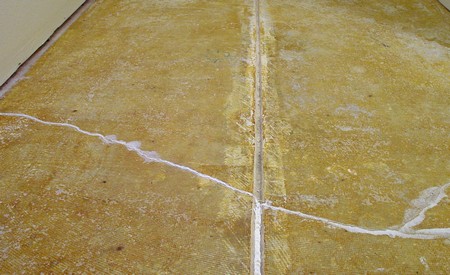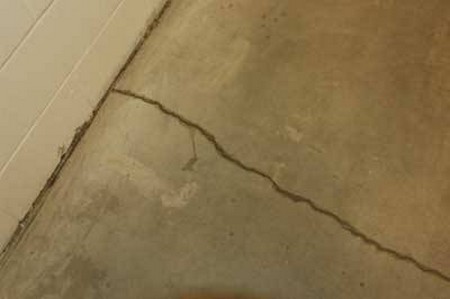There is no point in laying a new floor covering of any kind on a faulty base, so the first thing to do is to have a good look at the floor and to assess whether it is in a good state of repair-or not.
SOLID FLOORS
The two main things you will be looking for here are unevenness (or breaking up) of the surface and damp.
Some floor coverings (such as cork or thin timber) demand a substrate that is absolutely flat. In these cases, an uneven solid floor, which might look fine if overlaid with less susceptible coverings, will have to be levelled in some way. If the floor is sound and basically dry, this is easily achieved using a floor levelling compound.
Slightly damp floors can also be dealt with, but if the floor is beginning to break up or -shows signs of serious rising damp, it may be necessary to dig it up and re-lay it – a major undertaking. When dealing with a damp floor, you need to know whether the problem is rising damp or condensation.
TIMBER SUSPENDED FLOORS
A timber floor can be the victim of even more problems – the triple evils of damp, rot and woodworm. Before laying any floor covering, you should raise a few floorboards and have a good look around underneath with a torch, prodding any suspect areas with a sharp tool such as a small screwdriver or bradawl.
DAMP
In timber floors, whether in the floorboards or the joists, damp is the beginning of all the problems and greatly increases the likelihood of rot and woodworm. For this reason, the walls surrounding suspended floors should contain airbricks to allow a free flow of air around the timbers to keep them dry. Some people block these up thinking that this will save money on heating costs or they may become blocked up accidentally. First, make sure that these airbricks are unclogged and that there are enough of them – there should be one single (brick-size) 225 by 75 mm (9 by 3 in) airbrick for every 1.2 m (4 ft) of wall.
WET ROT
Water damage is one of those things that’s best left to the professionals. A damage restoration company can help you assess the damage and start the process of getting your home back to normal. Water damage itself can be a serious problem leading to staining and wood decay, but an attack of rot is worse if you still have not done a proper water damage restoration.
Wet rot is the most common and can be identified by a darkening, softening and splitting up of the timber, often with the timber cracking along the grain. A sharp tool can be pushed quite easily into affected areas. According to Stellar Restoration Houston, the damage is not difficult to repair once the rotten wood has been cut out, either by using a special hardener, followed by a filler for small attacks or by replacing the timber for more extensive outbreaks.
However, when the damage is extensive, don’t be afraid to ask for help from professionals as there are many emergency water damage restoration services there to help you fix it. There are even companies offering 24/7 Emergency Water Damage Floor Restoration services.
DRY ROT
An attack of dry rot, however, is far more serious. This is characterized by grey/ white strands on the surface of the timber, with the wood breaking into dry square-shaped pieces. In extreme cases, ‘fruiting bodies’ (a fungal growth) can form on the underside of the floorboards or the joists. The problem with dry rot (a misnomer since it happens only on damp timber) is that it can spread into, across and through masonry walls as well. The only solution is to remove – and burn – all affected timber (and plaster) and to replace it with new materials, treating all exposed surfaces with a special fungicide to prevent further attacks – a job probably best left to a professional remedial firm.
WOODWORM
What is known generically as ‘woodworm’ is attack by one of a number of flying beetles, which lay their eggs in cracks and crevices in the timber. When the eggs hatch, the resulting larvae burrow into the wood and then stay there for anything up to four years, eating their way through and weakening the timber. Eventually they turn into flying beetles, burrow their way out of the wood and fly off to lay their eggs elsewhere. The clue to woodworm attack is the holes made by the beetles when they leave. These mean that you have had an attack not that they are still there. However, if you see these visible ‘flight holes’, the timber should be treated with a woodworm killer, particularly if there is fresh bore dust (‘frass’) on the surface indicating that a beetle has left recently. Treating small areas of attack can be done on a do-it-yourself basis, but large outbreaks should be left to a professional firm with the equipment (sprays and lances) necessary to reach all the areas which might be affected.
LOOSE AND BOUNCY FLOORING
Before laying any new floor coverings on a suspended timber floor it is essential that you walk all over the floor to make sure there are no loose floorboards.
Jumping up and down on the floor – a ‘bounce’ test – will not only reveal loose floorboards but may also tell you about joists which have been weakened by attacks of rot or woodworm.

